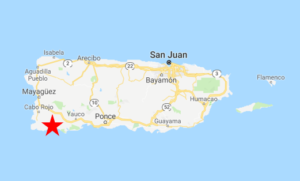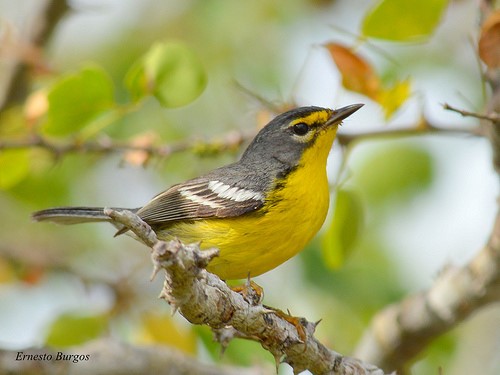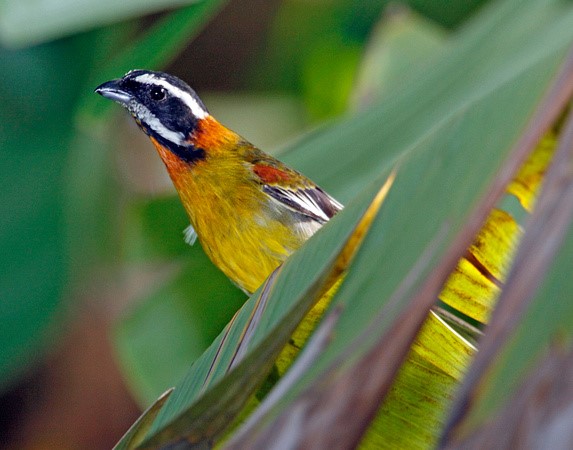La Parguera, Puerto Rico

The seaside resort town of La Parguera is known for boating, fishing, and one of the world’s few bioluminescent bays—but most of all for its Yellow-shouldered Blackbirds. On the streets of La Parguera, this endangered species is a trash bird, both because it is easy to find and because it literally eats trash. The skies are nearly always clear and it is easy to relax and stroll, and with little effort find an interesting diversity of birds.
Orientation
Directions
Two hours’ drive (170 km) southwest of San Juan, 50 minutes (60 km) west of Ponce, or 45 minutes (35 km) south of Mayagüez.
From Ponce and Points East. Begin westbound on PR-2 and after about 30 km exit onto PR-116 toward Guánica. Remain on PR-116 for 20 km, then turn left onto PR-304, which takes you into La Parguera.
From Mayagüez. Begin southbound on PR-2. After approximately 15 km, exit onto PR-116. From here, the route to La Parguera zig-zags to avoid the urban centers of San Germán and Lajas.
On PR-116, after about 2 km of farm fields, you will reach a small neighborhood of houses. Turn right into this neighborhood, go 300 m, then turn right again, and drive another 1.7 km to the junction with PR-114.
Turn left onto PR-114, go 1.1 km, and fork right onto PR-102. Continue straight on this road, which becomes PR-318 and winds up into the hills above San Germán.
After 2.2 km, reaching a T-junction, turn right onto PR-101, go 600 m, then turn left onto PR-321, go another 1 km, and turn right onto PR-122 (a minor freeway).
Remain on PR-122 (which again becomes PR-116) for approximately 8 km, then turn right onto PR-304, which takes you into La Parguera.

Yellow-shouldered Blackbird at La Parguera. © Michael J. Morel
Birdfinding
La Parguera is productive for birdwatching because its shoreline is the edge of a large mangrove swamp. Although the town has displaced part of the swamp, clumps of mangroves remain along its streets, providing easy access to habitat that supports a wide array of birds. Many species of herons and wintering shorebirds and warblers can often be found by strolling through the town.
Birds that are typically present in the area include: “Caribbean Clapper Rail”, Eurasian Collared-Dove, African Collared-Dove, Mangrove Cuckoo, Antillean Nighthawk (summer), Puerto Rican Nightjar (in the hills above the town), Puerto Rican Mango, Puerto Rican Tody, Caribbean Elaenia, Puerto Rican Flycatcher, Gray Kingbird, Caribbean Martin (summer), Bronze Mannikin, Indian Silverbill, Pin-tailed Whydah, Venezuelan Troupial, Yellow-shouldered Blackbird, Shiny Cowbird, Greater Antillean Grackle, Northern Waterthrush (winter), Northern Parula (winter), “Golden Warbler”, Prairie Warbler (winter), Adelaide’s Warbler, Puerto Rican Spindalis, Black-faced Grassquit, and Puerto Rican Bullfinch.
There are two main areas to visit: downtown and the shoreline road west of town.
Downtown Shorefront. Yellow-shouldered Blackbird can be found in the immediate vicinity of Parador Villa Parguera, a seaside hotel and restaurant in the center of the town. This has long been a popular choice of lodging for visiting birdwatchers.
Villa Parguera is on the main street, PR-304, in the short stretch where it passes beside the shore. There is a parking lot at the west end of the property, and streetside parking is also available nearby.

Adelaide’s Warbler is common at La Parguera. © Ernesto Burgos
About 50 m directly offshore from Villa Parguera is a mangrove island that supports a significant breeding colony of Yellow-shouldered Blackbirds. If not otherwise in evidence, they can usually be seen flying to or from the island.
Another way to find the blackbird is to walk west from Villa Parguera and track down one of the mixed flocks of icterids that typically scour the sidewalks and lawns. These urban flocks usually include Greater Antillean Grackles and Shiny Cowbirds along with Yellow-shouldered Blackbirds.
Walking west through the town on Camino Puerto Viejo, you will pass beside many boathouses and docks, as well as the large public boat-ramp, set in a partially intact mangrove swamp. This area can be productive, with “Caribbean Clapper Rail” and an assortment of landbirds. From September to April, several species of warblers, including Northern Waterthrush, Northern Parula, and Prairie Warbler, are common, and many others are likely to be present in small numbers.
West of Downtown. About 1 km west of Villa Parguera, Camino Puerto Viejo turns inland and the development ends. A dirt road continues west along the shore for another 1 km or so, passing beside mostly unbroken mangrove swamp.
The habitat along the road is more diverse than in the town itself, with two large impoundments and fields on the inland side, and some open shallows mixed into the mangroves on the seaward side.
Following Camino Puerto Viejo inland through a small housing development, making any turns necessary to continue inland, will take you to the brush and patches of deciduous forest in the hills above La Parguera, where Puerto Rican Nightjar is resident.
Services
Accommodations
Among La Parguera’s several hotels, the most prominent and most often recommended is the Parador Villa Parguera (+1-787-899-7777), which is comfortable, centrally located, and a reliable spot for Yellow-shouldered Blackbirds.
Other reasonable alternatives nearby include La Jamaca Hotel y Restaurant (+1-787-899-6162) and the Turtle Bay Inn (+1-787-899-6633).
Food
La Parguera has many good restaurants and a few grocery stores. One establishment that suits most needs, from breakfast to dinner, snacks, and groceries, is the M&M Bakery & Deli, located on the east side of PR-304 about a block inland from the point where it meets the shoreline.
Notes
When to Visit
La Parguera is an exceedingly popular recreation spot, and becomes crowded and loud on weekends and holidays.
